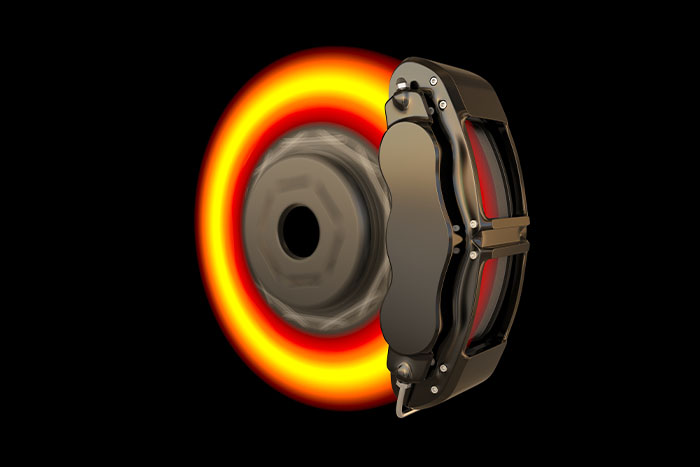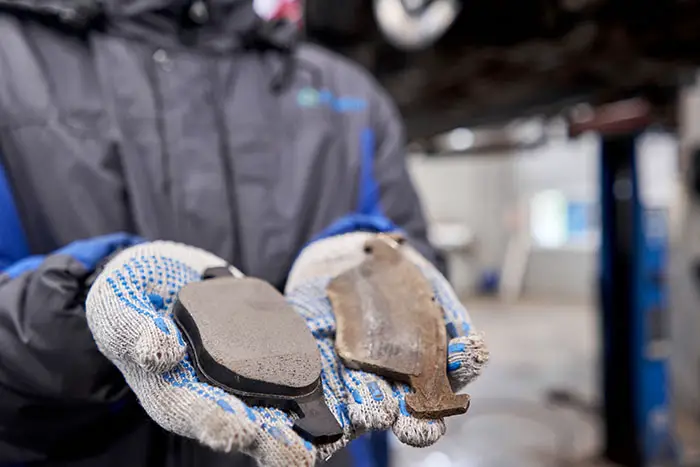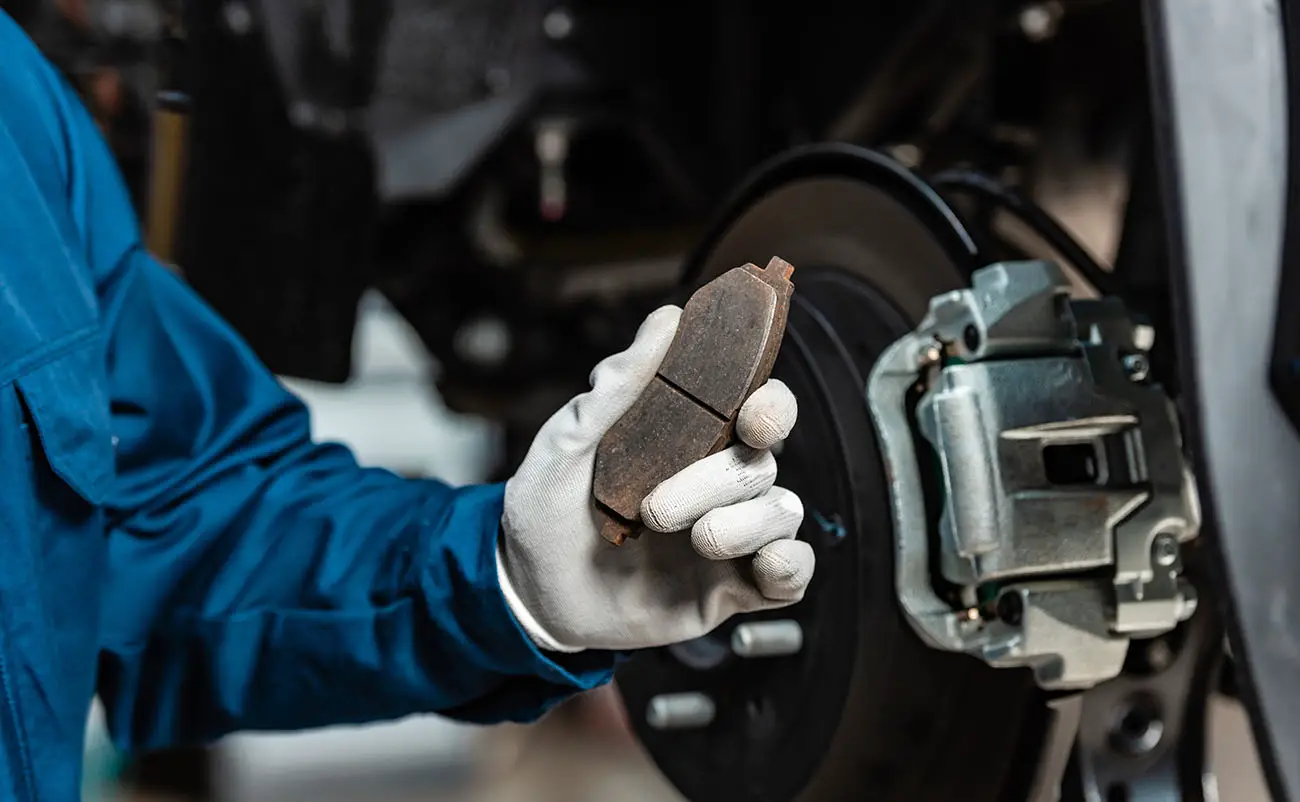Pressing your brake pedal and having nothing happen might be one of the worst fears of drivers out there. Brake pads are critical to your braking system, and they are the main piece of the puzzle to stopping your car. If your pads get too worn, your car might have trouble stopping. At the very least, it might require more distance to stop, which can also be dangerous. When it comes time to replace your brake pads, how much can you expect to pay? We will tell you everything you need to know about brake pad replacement, including how much it costs and even how to do it yourself!
Table of Contents
Brake Pad Replacement Cost
So, how much should it cost to replace brake pads and rotors? Brake service cost depends on a few different factors, but the average price for pad replacement is about $250 per axle. If you need to replace the rotors simultaneously, brake pad and rotor replacement costs usually come in around $600 per axle. Organic and semi-metallic pads are relatively cheap. A set of brake pads can be purchased for approximately $50 in most cases. Remember that a set is either for the front or back, but not both. Front brake pads and rear brake pads are typically about the same price.
If your car requires ceramic pads or you decide to purchase upgraded aftermarket brake parts like Akebono or Wagner, then you might spend $150 to $200 on the pads alone. The make and model of your vehicle heavily influence the price of the job because high-end cars require much more expensive parts. While brake pads for a Honda Accord might cost $40, brake pads needed for your Mercedes-AMG might be $200.
A typical brake job will take an experienced mechanic about an hour to complete for the pads alone, so the labor costs will run from $75 to $150. If rotors also need replacing, you can almost double the time required. While it might not be fun to spend money on brake repairs or brake replacement, brake maintenance is absolutely something that you do not want to ignore!
What Are Brake Pads & How Do They Work?

Before we get into the details of brake pad replacement, let’s discuss your braking system in general and how the pads fit in. Brake pads are only one piece of the overall system. We will only be discussing disc brake systems since brake drums on older cars do not include brake pads – they have brake shoes instead. First, your vehicle has brake rotors behind each wheel. The wheel is connected to the rotor, so as your wheels spin, the rotors also spin.
These rotors have brake calipers sitting on them. The caliper is similar to a ‘C’ shape, with one side of the caliper on each side of the rotor. They sit incredibly close to the rotors, but they do not touch them. Inside the calipers are the brake pads. The brake pads come into contact with the rotor and cause your car to slow down and stop.
When you press your brake pedal, the hydraulic brake fluid is forced down into the calipers. When this happens, the calipers use hydraulic pressure to press the brake pads against the rotors. As the pads clamp down on the rotors, the wheels of your car will slow down and eventually come to a stop. The harder you press the brake pedal, the harder the pads will clamp against the rotors.
Brake pads can be made from a few different materials. The most common types are organic materials (non-metallic pads), semi-metallic pads, and ceramic brake pads. Each class has strengths and weaknesses, and the kind that you use depends on your specific application. Pads required on a daily driver are different from those used on a performance vehicle.
Symptoms Of Worn Brake Pads

So, how do you know when it is time to change your brake pads? If you listen and pay attention, your car will tell you! It will show signs that you can recognize that will notify you that it is probably time for a brake pad replacement.
— Squealing Or Screeching Noise
Most brake pads have wear indicators that will help notify you when it is time to change them. This indicator is a stiff metal strip that will begin to rub against the brake rotor as the pad wears down. Once the brake pad becomes too worn, that metal strip will rub against the rotor and begin to squeal or squeak. When you hear this noise, you should have your brake pads checked as it might be time for a replacement. Some modern cars even have electronic indicators inside them. Once the pad wears down enough, the circuit becomes broken in the indicator, and a warning light will illuminate on your dash.
— Increased Stopping Distance
This is a telltale sign of a car in need of brake service. If your vehicle begins to need a longer distance to come to a complete stop, then you should go ahead and take your car to a mechanic. This likely means that your pads are starting to get thin, and they cannot stop your vehicle with the same force that they once did. This symptom could signal other issues like a leaking master cylinder, so ensure that your car is inspected immediately.
— Grinding Noise
If you hear grinding when you hit the brakes, you may have waited too long to get that brake job done. This probably means that your pads have completely worn down to the metal backing plate on the pad. You now have the metal backing plate rubbing against the metal rotor, which can cause significant damage! Not only will it damage your rotors, but it could also cause your brake fluid to overheat and even start a fire! Do not ignore a grinding noise coming from your brakes, and do not continue to drive with your car in that condition.
— Pulsing Brake Pedal
When pressing your brake pedal, you might feel it pulsing, especially when stopping going downhill. While this often signals warped brake rotors, it is probably time to examine your pads as well. When the rotors get warped and need replacement, it is usually because the pads are causing excessive heat when stopping. Go ahead and have an auto repair shop check out your vehicle to determine the cause of the problem and get the issue corrected.
How Often To Perform Brake Pad & Rotor Replacement
So, how long do brake pads last and how often do you need to replace them? Most cars will need pad replacement every 40,000 to 60,000 miles. Of course, this depends on the make and model of your vehicle along with your driving habits. If you are a daily commuter and make frequent stops in traffic, then the lifespan of your pads will be less than those on a car with mostly highway miles.
In addition, your vehicle might have softer friction material in the pads that require changing every 20,000 miles. Conversely, you might be able to get 75,000 out of a set of pads. It depends on your specific situation as there is no one-size-fits-all approach to this question. Your owner’s manual generally will not specify a recommended interval either because you should replace your pads when they need it, not simply at a set mileage interval.
Changing Brake Pads On Your Own

Since your car’s brake pads only make up a fraction of the replacement cost, you might decide to change your pads to save some money. Changing your brake pads is not extremely difficult if you have a little bit of mechanical know-how. This is a DIY job that many shade tree mechanics tackle regularly. Many people wonder how to change brake pads, so keep reading.
First, you will want to remove your wheel. Most people opt to work on one wheel at a time. Next, you should unbolt and remove the caliper. You might need to wedge a screwdriver between the old pads and the rotor to help loosen the caliper. Be careful not to damage your brake lines when removing the caliper!
Once the caliper is off, then you can go ahead and pop the old pads out of the caliper. Once those are removed, you will need to use a clamp or something similar to press the piston back into the caliper. If you skip this step, you won’t be able to get the new brake pads back around the rotor. Once the piston is depressed, go ahead and put the new hardware and pads into the caliper and replace the caliper around the rotor.
Complete this same procedure at the other wheel on this axle. Once you are done, start your vehicle and slowly depress your brake pedal. It will likely go almost to the floor. Slowly release the pedal and then slowly depress it again. After about 3 or 4 presses of the pedal, it should feel normal again as the pistons work their way back against the pads. Drive your car and make a couple of hard stops to seat the pads, and you are all done!
The Bottom Line
Replacing your brake pads is not a very expensive or complex job. Since brake pads cost only about $50 for most cars, you can save yourself quite a bit of money by doing the work yourself. Even if you take your vehicle to the dealership, it should only set you back at around $300 unless you have a high-end car. If you notice any of the symptoms of worn pads, make sure that you address the issue right away. Continuing to drive can do additional damage and be extremely dangerous!
Frequently Asked Questions
Is it OK to replace brake pads only?
Yes, you might not need to replace your rotors each time you perform a pad replacement. You should check the thickness of your rotors and look for any corrosion to determine whether a rotor replacement is required. If not, then you can replace the pads and keep driving. If you are unsure, then you should check with your dealership or repair shop for assistance. If you have a car with a rebuilt title, make sure that you inspect all your brake parts when performing this job to make certain things look OK.
Is it cheaper to replace brake pads yourself?
Yes, you can save some money by performing the job yourself. Brake pad replacements are not covered under warranty anyway since they are considered a maintenance item. Replacement at a service center will likely set you back around $300 per axle, while you can probably perform the job yourself for around $100.
How often should brake pads be replaced?
Some people wonder when to replace brake pads. Brake pads should be replaced whenever they are too worn. There is no set interval for when this will occur. Most vehicles need brake pad replacement around every 40,000 – 60,000 miles. Your vehicle and driving style will play a role in how quickly your pads wear out. You might find yourself needing pads every 20,000 miles, while another person might only need them every 70,000 miles. You should keep a check on your pad thickness and have your car checked by a mechanic at the first symptom of worn pads.
What are the benefits of replacing brake pads?
Replacing brake pads is not something that you can ignore. You can expect your car to see decreased stopping distance after replacing your pads, which means that your vehicle will stop more quickly and smoothly. In addition, new pads will likely produce less heat which is better for your overall braking system. Finally, they might even produce less brake dust which means that your wheels will stay cleaner between car washes.

